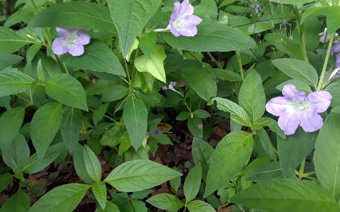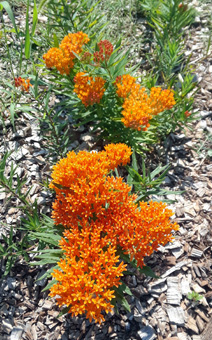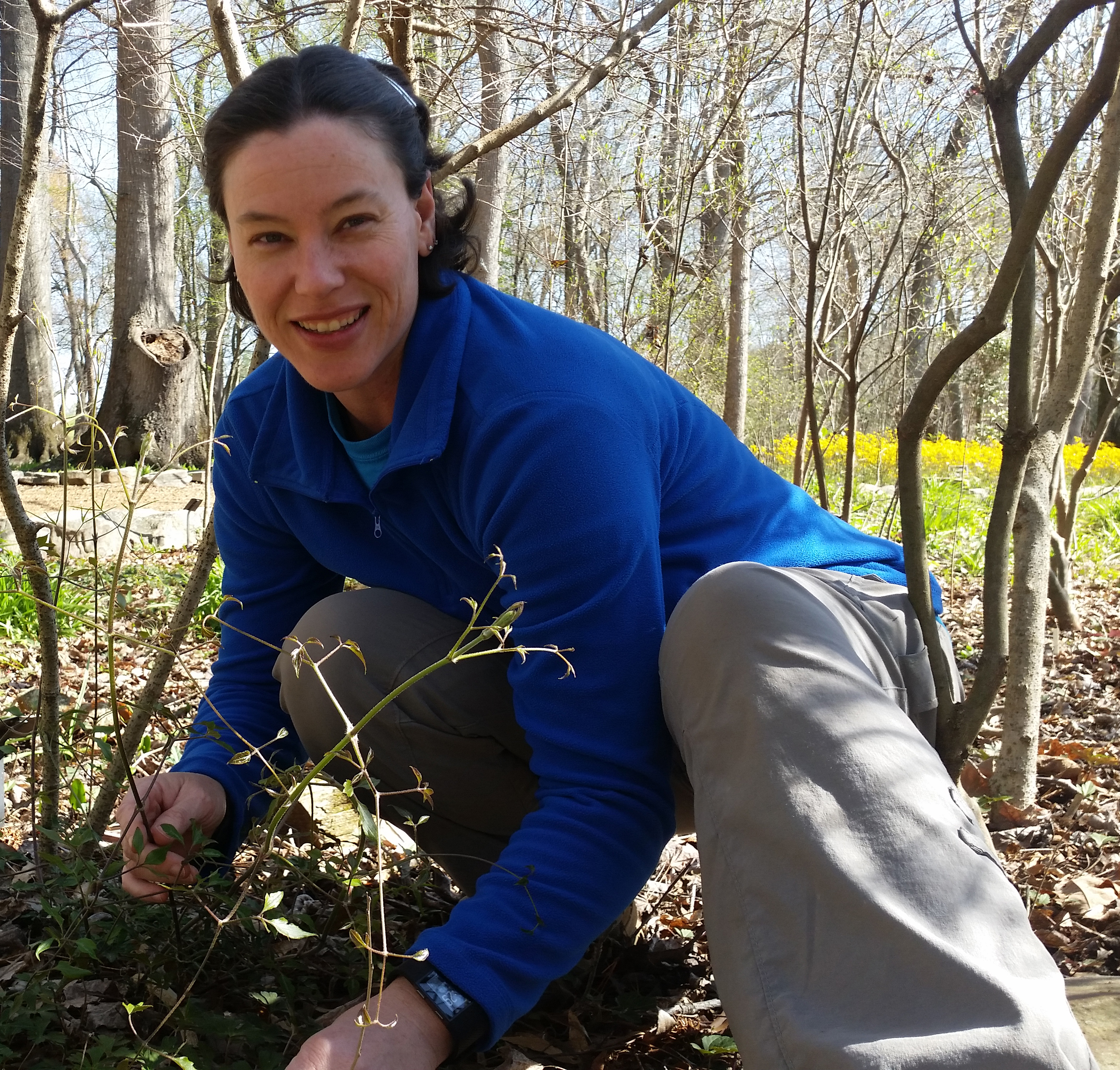
Hydrangea quercifolia, commonly called oakleaf hydrangea, is an upright to rounded, multi-stemmed, deciduous shrub that typically grows 6-8 feet tall and wide. This member of Hydrangeaceae (the Hydrangea family) is native to wooded bluffs, ravines, and stream banks in southeastern North America. It bears cone-shaped panicles of non-fragrant white flowers in the summer that are held on exfoliating branches with large oak-like, dark green leaves. Oakleaf hydrangea is easily grown in average to moist well-drained soils in full sun to part shade. Adding organic mulch will retain moisture and add nutrients to the soil, allowing this plant to thrive. This low maintenance plant needs little pruning to keep it in shape and it blooms on last year’s growth. It is effective as a specimen or accent, makes an excellent informal hedge, and is useful for naturalizing in open wooded areas. It has nice burgundy fall color and exfoliating mature branches provide interesting texture in winter. Makes a good cut flower fresh or dried.

Ruellia caroliniensis, commonly known as wild petunia, is an herbaceous perennial in Acanthaceae (often called the Bear’s breeches family). Wild petunia is one of only a few species in this family that are distributed in temperate regions, with the majority of genera found in Indonesia and Malaysia, Africa, Brazil, and Central America. This plant is endemic to dry-mesic hammocks and upland open woods throughout the southeastern U.S. It grows to 1-3 feet tall and 1.5-2 feet wide and prefers part shade and average to moist soils, but it is adaptable to full sun in clay soil. It features showy pale purple flowers that each only last for a day, but collectively they have a very long flowering period, starting in early June-August. A number of different varieties and forms occur throughout the eastern U.S. Wild Petunia is a host plant for the caterpillar of the Common Buckeye (Junonia coenia), and White Peacock (Anartia jatrophae), butterflies, and attracts many other pollinators. Use this easy-to-grow native instead of its widely-sold relative, the invasive Mexican petunia!

Rudbeckia maxima, commonly called large coneflower or cabbage leaf coneflower, is an herbaceous perennial in Asteraceae (the Aster family) that is native to open wooded areas, prairies, and along roads in southern-central North America. It features a basal clump of huge, glaucous, bluish-green leaves up to 2 feet long and bloom stalks up to 7 feet tall bearing yellow-rayed coneflowers with tall, dark brown central cones up to 6 inches in length! This perennial coneflower blooms in June and July and is easily grown in average, moist, well-drained soils in full sun. This native wildflower is an excellent addition to naturalized areas, wildflower meadows, cottage gardens, and native plant gardens, especially toward the back of borders. It has no serious insect or disease problems when grown in average, moist, or well-drained soils in full sun. It tolerates heat, drought, and deer browse very well and is somewhat adaptable to light shade. It attracts butterflies and birds. In particular, Goldfinches enjoy the seed if the bloom stalks are allowed to remain on the plant in the fall. Cabbage leaf coneflower makes a good cut flower, fresh or dried.

Echinacea ‘Cheyenne Spirit’ is a cultivar (cultivated variety) of a native coneflower that was introduced by Kieft-Pro Seeds in 2012. The Echinacea genus is composed of seven species of herbaceous perennials in Asteraceae (the Aster family) that are all native to eastern and central North America. ‘Cheyenne Spirit’ is a well-branched, sturdy coneflower that won the 2013 AAS (All-America Selections®) award and Europe’s FleuroSelect Gold Medal award for garden performance. It flowers the first year in a wide range of bloom colors and comes “true” from seed. It grows 2-2.5 feet tall, 1-2 feet wide, and blooms from June-August, in colors ranging from purple, pink, red, orange, yellow, cream or white with ray-like flowers featuring a brown cone center. Easily grown in average, dry to medium moisture, well-drained soils in full sun to part shade, but best in full sun. This adaptable plant is tolerant of drought, heat, humidity, deer, and poor soils. The dead flower stems will remain erect well into the winter, and if flower heads are not removed, the residuals cones will be visited by goldfinches or other birds that feed on the seeds. It puts on the best show when planted in groups on border fronts, or in rock gardens or part shade areas of open woodland gardens and attracts birds and butterflies. ‘Cheyenne Spirit’ makes a good fresh cut or dried flower. Deadheading is not necessary for rebloom but may keep the plants tidy as summer wears on.

Asclepias tuberosa, commonly called butterfly weed, is a species of perennial milkweed native to eastern North America. This member of Apocynaceae (the dogbane family) has tuberous roots occurs in dry/rocky open woods, glades, prairies, and roadsides; typically growing clumps up to 1-3 feet tall and wide. Butterfly weed features very showy clusters of bright orange to yellow-orange flowers on upright stems with narrow, lance-shaped leaves. Butterfly weed is one of 23 species of milkweed that grow in Alabama. Unlike many of the other milkweeds, this species does not have milky-sapped stems. After pollination, the seed pods split open when ripe, releasing numerous silky-tailed seeds for dispersal by the wind. Butterfly weed is favored for its long bloom period (June to August) and as a copious nectar source for many butterflies. The leaves are a food source for queen and monarch butterfly larvae (caterpillars) and the toxins they ingest with the leaf tissue makes them poisonous to most predators.
This low maintenance plant has no serious insect or disease problems so long as it is not grown in wet, poorly drained soils. Butterfly weed does not transplant well due to its deep taproot and is best left undisturbed once established. Please purchase seed or plants from a reputable source, as poaching has been a problem in wild populations in the past. Butterfly weed is easily grown in average, dry to medium, well-drained soils in full sun. It is tolerant of deer, drought, erosion, and poor shallow-rocky soil. Useful addition to butterfly gardens, meadows, prairies, or naturalized/native plant areas.

Monarda didyma, is commonly known by a number of different names including bee balm, Oswego tea, and bergamot. This member of Lamiaceae (the mint family) is native to eastern North America where it is broadly distributed in bottomlands, thickets, and moist woods and along streambanks. It is a coarse, clump-forming, herbaceous perennial that grows to 2-4 feet tall by 2-3 feet wide and features showy red-dark pink tubular, two-lipped flowers in a dense, globular, terminal inflorescence up to 3 inches across July to August. Blooms top upright square stems with opposite deep green leaves that emit a minty fragrance when bruised. Bee balm is prized for its long summer bloom period (up to 8 weeks) and attraction of pollinators; especially bees, hummingbirds, and butterflies. Best grown in rich, average to wet soils in full sun to part shade. Tolerates rabbit and deer browse, clay soil, wet soil, and resistant to the juglandins produced by black walnut. If conditions are favorable, it may spread by rhizomes and self-seed to form colonies, but it is easily controlled. Deadheading flowers can prolong summer bloom and can prevent spread from self-seeding. Makes a good fresh cut flower. Powdery mildew can be a serious problem, particularly in crowded gardens with poor air circulation.

